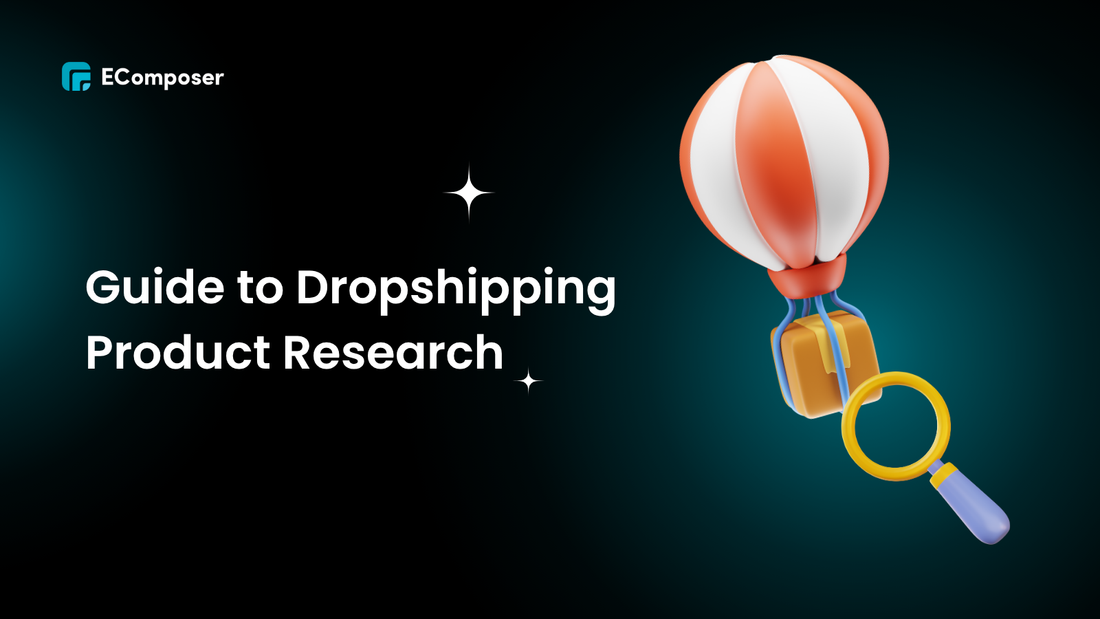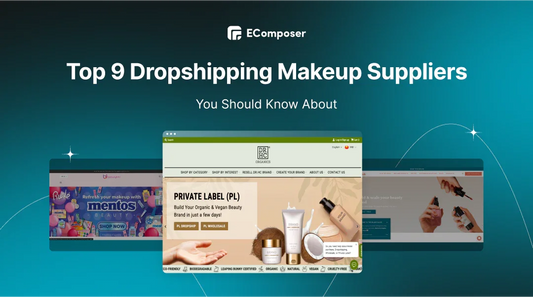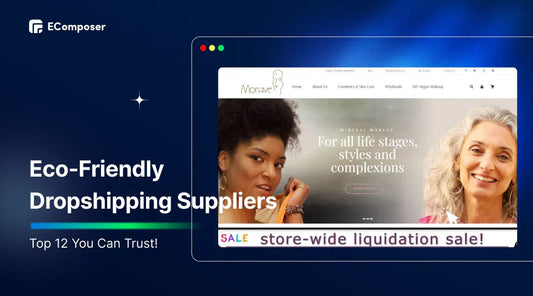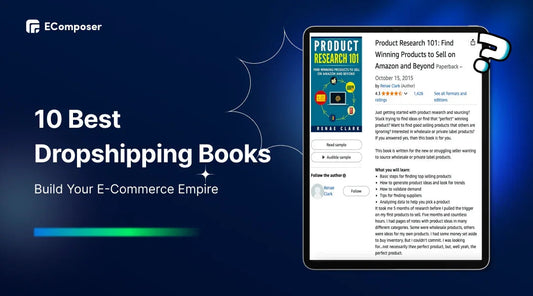The Guide to Dropshipping Product Research (Methods, Tools, Tips & Trends)

Table Of Contents
Introduction
In 2025, dropshipping is getting more and more competitive. There are over 288 million online shoppers in the U.S., and platforms like TikTok Shop, Instagram Shopping, and Amazon are helping sales go viral. Entrepreneurs often have a hard time with claims of "winning products" and market trends.
This guide aims to help you overcome these problems by giving you a step-by-step plan for always finding dropshipping products that will make you money before the market becomes saturated. It has step-by-step research methods, suggested research tools for products, and tips from industry experts, agencies, and successful e-commerce sellers.
Why Dropshipping Product Research Matters
Choosing the wrong product doesn’t just mean lost sales; it can mean weeks of wasted time, money sunk into ads, and a hit to your confidence. The difference between a store that fizzles and one that scales often comes down to one thing: research.
- Market growth is real but competitive: This market was worth USD 365.67 billion in 2024, and it's expected to be worth USD 1,253.79 billion by 2030, thanks to a compound annual growth rate (CAGR) of 22.0% from 2025 to 2030.
- Consumers are picky: Fast shipping, quality assurance, and authentic branding now matter as much as price.
- Platforms are smarter: Facebook, TikTok, and Google Ads demand better targeting, making product validation essential.
In short, dropshipping product research isn’t a “nice-to-have”; it’s the foundation of your business survival and growth.
Key Benefits of Proper Research
- Spot true winners early: Identify profitable dropshipping niches with low competition before saturation.
- Save ad spend: Validate demand before investing in campaigns.
- Predict trends: Use market demand analysis and AI forecasting to ride seasonal waves profitably.
- Choose reliable suppliers: Avoid shipping delays and poor-quality products.
- Scale sustainably: Build a portfolio of both viral winners and evergreen products for consistent ROI.
You might be interested in:
- 14 Best Dropshipping Suppliers with Fast Shipping (1-3 days)
- Top 8 Luxury Dropshipping Suppliers
- Top 10 Dropshipping Product Finder Tools
The Most Effective Dropshipping Product Research Methods
There are two main approaches, manual and tool-based. Both can uncover profitable products, but the right choice depends on your budget, experience, and scaling goals.
Manual Method (Free)
When budgets are tight, manual research is still a powerful entry point. It’s slower, but it teaches you how the market really works.
- Social media sleuthing: Scan TikTok, Instagram Reels, and Facebook Marketplace for products with viral engagement.
- Google Trends: Validate whether a spike is seasonal or long-term.
- Competitor store checks: Use Shopify “inspect” tricks or browse bestsellers on Amazon and eBay.
- Reddit & niche forums: Communities often reveal emerging trends before they hit the mainstream.
Using Specialized Product Research Tools (Paid)
When time is more valuable than money, paid tools give you leverage. These dropshipping product research tools combine automation, AI, and real-time data to find winning products faster.
Key features to look for:
- Trend analysis dashboards: Real-time insights from TikTok, AliExpress, and Amazon.
- Competition monitoring: Track top Shopify stores and reverse-engineer their campaigns.
- Profitability scoring: Estimate ROI with built-in calculators.
- Supplier links: Direct access to vetted suppliers on Spocket, CJDropshipping, or AliExpress.
- Integrations: One-click import into Shopify, WooCommerce, or even TikTok Shop.
Examples include:
- Ecomhunt & Sell The Trend → beginner-friendly with curated lists.
- Niche Scraper & Minea → advanced analytics + ad library.
- Premium suites (e.g., Droppoint, PPSpy, Tradelle) → multi-client dashboards for consultants/agencies.
Criteria for Evaluating a Potential Dropshipping Product
The difference between profitable dropshipping products and dead inventory often comes down to careful evaluation. Here are the key criteria seasoned entrepreneurs use to separate fads from long-term winning products for dropshipping.
Solve a Problem or Satisfy a Passion
The most enduring dropshipping niches aren’t built on random products; they’re built on solutions and desires. Ask yourself: Does this product make someone’s life easier, or does it fuel a strong passion?
- Problem-solving examples: ergonomic laptop stands for digital nomads and leak-proof pet water bottles for dog owners.
- Passion-driven examples: collectible K-pop merchandise and fitness accessories for the New Year’s resolution crowd.
Products that either remove a pain point or feed an obsession tend to inspire repeat purchases and word-of-mouth buzz.
Attractive Profit Margin
Low prices may attract buyers, but low margins kill businesses. To evaluate a product, calculate its potential profit:
- Profit = Selling Price – (Product Cost + Shipping + Marketing)
- Aim for at least 20–30% margins after all costs.
- Tools like AliExpress Dropshipping Center or Spocket’s margin calculator can help estimate profitability before you commit.
Margins are your safety net. They allow room for ad testing, promotions, and inevitable returns.
Not Easily Found in Local Stores
If customers can grab it at Walmart or Target, why would they wait two weeks for shipping? The magic of profitable dropshipping niches lies in exclusivity. Look for products that are:
- Unique to online channels.
- Difficult to find in mainstream brick-and-mortar stores.
- Popular in niche communities (e.g., TikTok micro-trends or hobbyist Facebook groups).
Scarcity creates urgency, and urgency drives conversions.
“Wow” Factor or Uniqueness
In 2025, attention is the new currency. A product needs that scroll-stopping quality to shine on platforms like TikTok Shop or Instagram Reels. The “wow” factor often comes from:
- Innovative design (a self-stirring mug).
- Novel features (a phone case that doubles as a sanitizer).
- Viral appeal (glow-in-the-dark basketballs).
Remember: social media algorithms reward products people can’t help but share.
Market Demand and Trends
Never trust your gut alone; let the data confirm demand. Check tools like:
- Google Trends for search interest.
- TikTok hashtags for viral momentum.
- Amazon Best-Sellers for proven demand.
Those associated with emerging consumer behaviors, eco-friendly items, health tech, or mobile-first gadgets will be more likely to capture a portion.
Competition Level
High demand is useless if the market is overcrowded. Evaluate:
- Number of stores selling the same item (use SEMrush or SimilarWeb for competitor analysis).
- Advertising saturation (search Facebook Ads Library for similar products).
- Differentiation potential (can you improve branding, bundle offers, or customer experience?).
The sweet spot? Moderate demand with manageable competition, a space where your branding and marketing can shine without getting drowned out.
Step-by-Step Dropshipping Product Research Process
Step 1 – Think about Who You Want to Reach and What You Sell
Before diving into dropshipping product research tools, zoom out and ask: Who am I selling to, and why?
- A niche isn’t just “fitness products”; it could be “eco-friendly yoga gear for millennials in urban areas.”
- Your audience persona should include demographics (age 25–45, side-hustlers, Gen Z trend-seekers) and psychographics (passion-driven, price-sensitive, or status-driven).
The more specific you are, the easier it becomes to filter out irrelevant products and spot the ones that resonate emotionally.
Step 2 – Use Data-Driven Tools to Spot Trends
Gut feeling might work once, but data wins consistently. Tools like:
- Google Trends → Track if interest is growing or fading.
- TikTok Creative Center → See what’s going viral among 1.5 billion users in 2025.
- AliExpress Dropshipping Center or Amazon Movers & Shakers → Identify fast-rising items.
Trend analysis helps you avoid saturated products and jump on rising waves early, before the market gets crowded.
Step 3 – Analyze Competitors’ Stores and Ads
Want a shortcut to what works? Spy on competitors.
- Use Facebook Ads Library or PPSpy to see ads currently running.
- Check Shopify competitor stores with tools like SimilarWeb or SEMrush.
- Look at ad engagement, comments reveal frustrations, while shares reveal excitement.
This dropshipping competitor analysis strategy not only shows what’s trending but also exposes gaps you can exploit (better branding, faster shipping, or stronger positioning).
Step 4 – Validate Products With Market Demand Tools
Even a “viral” product can flop if demand is short-lived. Validation means confirming steady buyer interest.
- Google Keyword Planner: Search volumes prove long-term demand.
- Etsy Trends or eBay Watch Count: Show consumer purchase intent.
- Helium 10 or Jungle Scout: Originally for Amazon sellers, but great for measuring demand consistency.
Remember: true product validation goes beyond hype; it’s about proving demand forecasting with hard data.
Step 5 – Check Supplier Quality and Shipping Speed
Even the best product fails if suppliers can’t deliver. Vetting suppliers is part of smart dropshipping supplier research techniques.
- Test sample orders to check quality, packaging, and shipping time.
- Platforms like Spocket or SaleHoo can connect you with vetted suppliers.
- Pay attention to customer service responsiveness; delays here often predict future headaches.
Think of suppliers as your silent business partners; if they fail, you fail.
Step 6 – Calculate True Profit Margins
Numbers don’t lie. A product that looks exciting can sink your store if the math doesn’t work out.
- Use this formula:
Profit = Selling Price – (Product Cost + Shipping + Ads + Platform Fees)
- Aim for 20–30% profit margins, especially if relying on paid ads.
- Consider hidden costs like refunds, influencer partnerships, or seasonal discounts.
Smart profit margin calculation is what separates hobbyists from professional e-commerce entrepreneurs.
Step 7 – Test Small Before Scaling Big
Never scale blind. Instead:
- Run small ad tests on TikTok, Instagram, or Facebook.
- Set a modest budget ($50–$100) to gauge CTR, conversion rate, and cost per purchase.
- If metrics meet your benchmarks, then double down and scale.
This approach keeps your risk low while allowing data, not emotions, to guide your scaling decisions.
Best Dropshipping Product Research Tools in 2025
Product Discovery Platforms
Sell The Trend
- What it is: An all-in-one dropshipping analytics platform that scans marketplaces and social media to uncover trending products.
- Features: AI-powered product insights, Shopify & WooCommerce integration, audience targeting data, and video ad examples.
- Pricing: From $39/month, with a free trial.
- Best for: Aspiring e-commerce entrepreneurs who want one platform to handle trend discovery, validation, and store integration.
Ecomhunt
- What it is: A curated product discovery hub highlighting daily handpicked winning products for dropshippers.
- Features: Product profitability scores, Facebook ad examples, targeting suggestions, and competitor store links.
- Pricing: Free limited version; Pro starts at $29/month.
- Best for: Side-hustle seekers with limited startup capital who want shortcuts to ready-to-test winning products.
Minea
- What it is: A social commerce intelligence tool specializing in ad spying across Facebook, TikTok, and Instagram.
- Features: Advanced filters (ad spend, engagement, duration), influencer campaign tracking, competitor brand monitoring.
- Pricing: Starter plan at €49/month.
- Best for: Marketing agencies and digital nomads needing granular ad data to uncover viral winning products for dropshipping.
Ad Spy Tools
BigSpy
- What it is: A massive ad spy database covering millions of ads across multiple platforms.
- Features: Search by keyword, advertiser, or platform; ad creatives archive; competitor targeting insights.
- Pricing: Free basic tier; premium from $9/month.
- Best for: E-commerce consultants comparing ad strategies and spotting product trends before they saturate.
PowerAdSpy
- What it is: A competitor intelligence tool for tracking Facebook, Instagram, and Google Ads.
- Features: Advanced filters (CTA, engagement, niche), ad performance tracking, and geo-target insights.
- Pricing: From $49/month.
- Best for: Affiliate marketers who rely on paid traffic and want to uncover dropshipping competitor analysis strategies.
PiPiAds for TikTok
- What it is: The leading TikTok ad spy tool, crucial with TikTok projected to hit 950M+ users in 2025.
- Features: Viral product library, ad performance metrics, store links, and creative inspiration.
- Pricing: Starts at $77/month.
- Best for: Gen Z-driven e-commerce sellers tapping into viral trends and profitable dropshipping niches with low competition.
Market Data & Trend Tools
Google Trends
- What it is: A free market demand analysis tool showing real-time and historical search trends.
- Features: Regional demand maps, seasonal trend analysis, and keyword comparisons.
- Pricing: Free.
- Best for: Beginner dropshipping product research guide users, validating demand before investing in ads.
Exploding Topics
- What it is: A platform that spots emerging consumer trends before they peak.
- Features: AI-based trend forecasting, category filtering, and trend growth scoring.
- Pricing: Free version; Pro from $39/month.
- Best for: Small business owners transitioning online who want a first-mover advantage in fast-rising markets.
TikTok Creative Center
- What it is: TikTok’s official tool for analyzing viral ads, hashtags, and music trends.
- Features: Top-performing ad database, regional trend tracking, niche-specific creative inspiration.
- Pricing: Free.
- Best for: Existing online sellers looking to expand with TikTok Shop and viral content strategies.
Supplier Marketplaces
AliExpress
- What it is: The most recognized dropshipping supplier marketplace, offering millions of low-cost products.
- Features: AliExpress Dropshipping Center, wide supplier choice, and global shipping.
- Pricing: Free to use (pay product costs).
- Best for: Beginner entrepreneurs testing product ideas quickly without upfront bulk orders.
CJDropshipping
- What it is: A supplier sourcing platform with U.S. and EU warehouses for faster shipping than AliExpress.
- Features: POD (print on demand), one-on-one sourcing requests, and API integrations.
- Pricing: Free platform; pay only for product cost + shipping.
- Best for: Digital nomads and sellers focused on supplier reliability verification and speed.
Spocket
- What it is: A premium supplier directory focusing on U.S. and EU products for faster delivery.
- Features: High-quality vetted suppliers, branded invoicing, Shopify/WooCommerce integration.
- Pricing: Free plan; paid plans from $29/month.
- Best for: Brands scaling beyond side hustles and aiming for a stronger customer experience with fast, branded delivery.
Dropshipping Product Research Tips
How to Spot Products Before They Go Saturated
Most beginners chase after viral products once they’ve already peaked. By then, ad costs are sky-high, and competitors are flooding the market. The trick is to catch products in the early growth stage, before saturation hits.
- Use tools like Google Trends or Exploding Topics to spot demand spikes.
- Monitor niche-specific TikTok hashtags where Gen Z users are driving trends first.
- Look at order growth velocity on AliExpress or CJdropshipping, not just total sales.
Think of it like surfing, you want to catch the wave before it crests, not when everyone else is already riding it.
Combining Social Media and Data Analytics for Faster Validation
Social media is today’s crystal ball for demand. A product going viral on TikTok or Instagram is often a sign of future growth, but don’t just rely on hype. Combine it with market demand analysis tools:
- Track ad spend with Minea or PiPiAds to confirm real campaigns are backing the product.
- Cross-check search traffic with SEMrush or Google Keyword Planner.
- Validate suppliers with reviews and fulfillment speed metrics.
This hybrid approach, social buzz + hard data, saves you from chasing fads and keeps your research grounded in reality.
Leveraging AI for Smarter Product Predictions
AI is reshaping market analysis. Platforms like Sell The Trend and Dropship.io now predict demand shifts before they hit mainstream.
- AI models detect micro-trends in product categories.
- Automated alerts flag when a product’s growth curve is about to accelerate or decline.
- Competitor ad monitoring at scale helps you react in real time.
Dropshippers using AI-backed tools tend to have faster validation cycles compared to manual research. Ignore AI in 2025, and you’ll be running half-blind.
The 80/20 Rule in Product Testing
Here’s the truth: 80% of your testing effort will only produce 20% of your winners. But that 20% is where your profits lie.
- Test multiple products, but don’t fall in love with any one idea.
- Kill losers quickly, within 72 hours, if CTRs and CPAs don’t look promising.
- Scale your winners methodically with structured ad budgets.
Like panning for gold, most rocks don't pay anything, but sometimes you get lucky and find a real treasure.
Use Forums and Deep Communities
Sometimes, the best insights come from where real customers hang out, not dashboards.
- Browse Reddit (r/dropship, r/ecommerce) for product buzz.
- Lurk in Facebook groups where enthusiasts discuss hobbies and pain points.
- Check Etsy trends or niche subcultures for unique ideas.
These communities often reveal frustrations and desires that no AI tool can yet quantify, giving you a first-mover advantage.
Product Scalability
Not every product is built for long-term growth. A one-hit wonder might make you quick cash, but scalable products sustain your business. Look for:
- Cross-selling potential (e.g., resistance bands → yoga mats → fitness apparel).
- Evergreen demand (pet supplies, kitchen tools, skincare).
- Supplier capacity: Can they handle 1,000 orders a day without crumbling?
In 2025, the most successful dropshipping products will not be sold once but rather developed into entire lines.
"Follow the Influencer" Strategy
When you see an influencer pushing a new gadget, don’t just scroll; analyze it. Influencers often test products before they trend mainstream.
- Use the TikTok Creative Center to see what influencers are advertising.
- Check engagement levels; if a micro-influencer campaign is gaining steam, you may be early.
- Track affiliate-driven pushes in your niche; they often forecast viral potential.
Keep in mind that influencers function as the tastemakers of today. The people you follow today will be the ones to lead tomorrow.
Don’t Ignore Customer Feedback
Product reviews are like gold in dropshipping product validation. Customers don’t just complain; they tell you exactly how to improve.
- Spot recurring pain points (slow shipping, poor quality).
- Identify upsell opportunities (“wish it came with X feature”).
- Tracking review timelines and improving supplier quality often shifts ratings dramatically.
One overlooked Amazon review thread could save you thousands in refunds and chargebacks.
Don’t Set Unrealistic Expectations
Dropshipping isn’t a get-rich-quick scheme. Chasing viral products without understanding margins, supplier reliability, and ad costs sets you up for burnout.
- Average dropshipping conversion rates sit around 2–4% in 2025.
- Profit margins vary, but expect 15–30% on average.
Set goals grounded in reality; steady growth beats flash-in-the-pan hype every time.
Don’t Try to Sell Too Much
One of the biggest mistakes I see aspiring e-commerce entrepreneurs make is launching a general store with 500 products, hoping something sticks.
- Start lean; 5 to 10 carefully validated products are enough.
- Focus on storytelling and brand-building around each product.
- Add more once you’ve proven traction and can scale.
Trying to sell too many products spreads your marketing dollars thin and confuses your audience.
Dropshipping Product Research Trends in 2025
If there’s one thing constant in dropshipping, it’s change. The way entrepreneurs discover winning products today looks very different from how it did even two years ago, and 2025 is no exception. From AI-powered dropshipping product research tools to the explosion of TikTok Shops, and from micro-niches to sustainability-driven buying habits, new trends are shaping how aspiring e-commerce entrepreneurs, side-hustlers, and digital nomads uncover the next big product.
Let’s explore the key shifts you need to watch.
The Rise of AI-Powered Research Tools
Tools like Tradelle, Sell The Trend, and Dropship.io use machine learning to predict trends before they hit mainstream adoption.
- AI scans millions of data points across Amazon, TikTok, AliExpress, and Shopify to forecast demand.
- Automated product validation highlights whether an item has sustainable margins or will be a one-hit wonder.
- Predictive analytics allows you to act days or even weeks faster than competitors.
Think of AI as your silent co-founder: always crunching numbers, flagging early winners, and saving you from costly guesswork.
Social Commerce (TikTok, Instagram Shops) as Research Goldmines
With over 950 million TikTok users expected in 2025, social commerce is the new testing ground for profitable dropshipping products.
- TikTok hashtags like #TikTokMadeMeBuyIt expose viral items in real time.
- Instagram Shops and Reels reveal how products perform with Gen Z and millennial buyers.
- Monitoring ad libraries on Facebook Ads Manager shows where serious budgets are being placed.
For many entrepreneurs, TikTok has become the “new AliExpress,” a live, constantly updating showcase of customer desires.
Sustainability & Ethical Sourcing Driving Demand
Consumers, especially millennials and Gen Z, are no longer satisfied with cheap, disposable products. Ethical sourcing and eco-friendly practices are shaping demand in 2025.
- Shopify reports rising sales in eco-conscious categories like biodegradable kitchenware and sustainable apparel.
- Small business owners transitioning online are positioning themselves as “eco-friendly brands” to capture loyalty.
- Ethical sourcing stories aren’t just a marketing angle; they’re becoming a deciding factor in purchase intent.
If you can combine winning products with a genuine sustainability story, you’ll outshine competitors still chasing low-quality suppliers.
Micro-Niches Outperforming General Stores
The age of “general stores with 1,000 products” is fading. Instead, micro-niches are proving more scalable and brandable.
- Niche stores enjoy higher conversion rates, up to 2x compared to broad stores.
- Communities on Reddit, Discord, and niche Facebook groups reveal loyal audiences hungry for specialized solutions.
- A store selling “ergonomic home office gadgets” resonates more deeply than a generic “gadget store.”
In 2025, precision beats breadth. The dropshippers thriving are the ones who build trust in micro-communities.
Short-Form Video as a Validation Method
Forget spreadsheets; sometimes the best product validation happens in a 20-second video.
- Dropshippers are testing products with raw TikToks, gauging engagement before committing ad budgets.
- High watch time, shares, and comments are early signals of a winner.
- Even Instagram Reels and YouTube Shorts have become fast-track testing grounds.
Instead of launching a full campaign, entrepreneurs now “test with content”, a quick, low-cost way to see if a product resonates with real audiences.
Conclusion
The landscape of dropshipping product research in 2025 is more dynamic than ever. AI research tools give speed and clarity. Social commerce platforms act as living trend databases. Sustainability and micro-niches help differentiate your brand. And short-form video has become both marketing and validation rolled into one.
If there’s a golden rule, it’s this: follow the trends, but adapt them to your unique audience. The entrepreneurs who blend data, creativity, and authenticity will continue to discover winning products while others chase after saturated leftovers.
FAQs on Dropshipping Product Research
- What’s the best free tool for product research?
For beginners, AliExpress Dropshipping Center and Google Trends are solid free options. They won’t replace premium dropshipping product research tools, but they’re a strong starting point.
- How much time should I spend on research per week?
Plan for at least 5–7 hours weekly if you’re serious. Consistency matters; product research isn’t a one-off task, it’s an ongoing process.
- Can I start with just TikTok/Instagram for research?
Yes, but pair it with validation tools. TikTok and Instagram are great for spotting hot products, but confirm demand with search data or ad spend insights before scaling.
- How do I know if a product is oversaturated?
Warning signs include:
- Dozens of identical ads in the Facebook Ad Library.
- Thousands of duplicate listings on AliExpress.
- Declining engagement rates on TikTok videos for the same item.
If you’re seeing more competition than conversation, you’re likely late to the party.





















0 comments